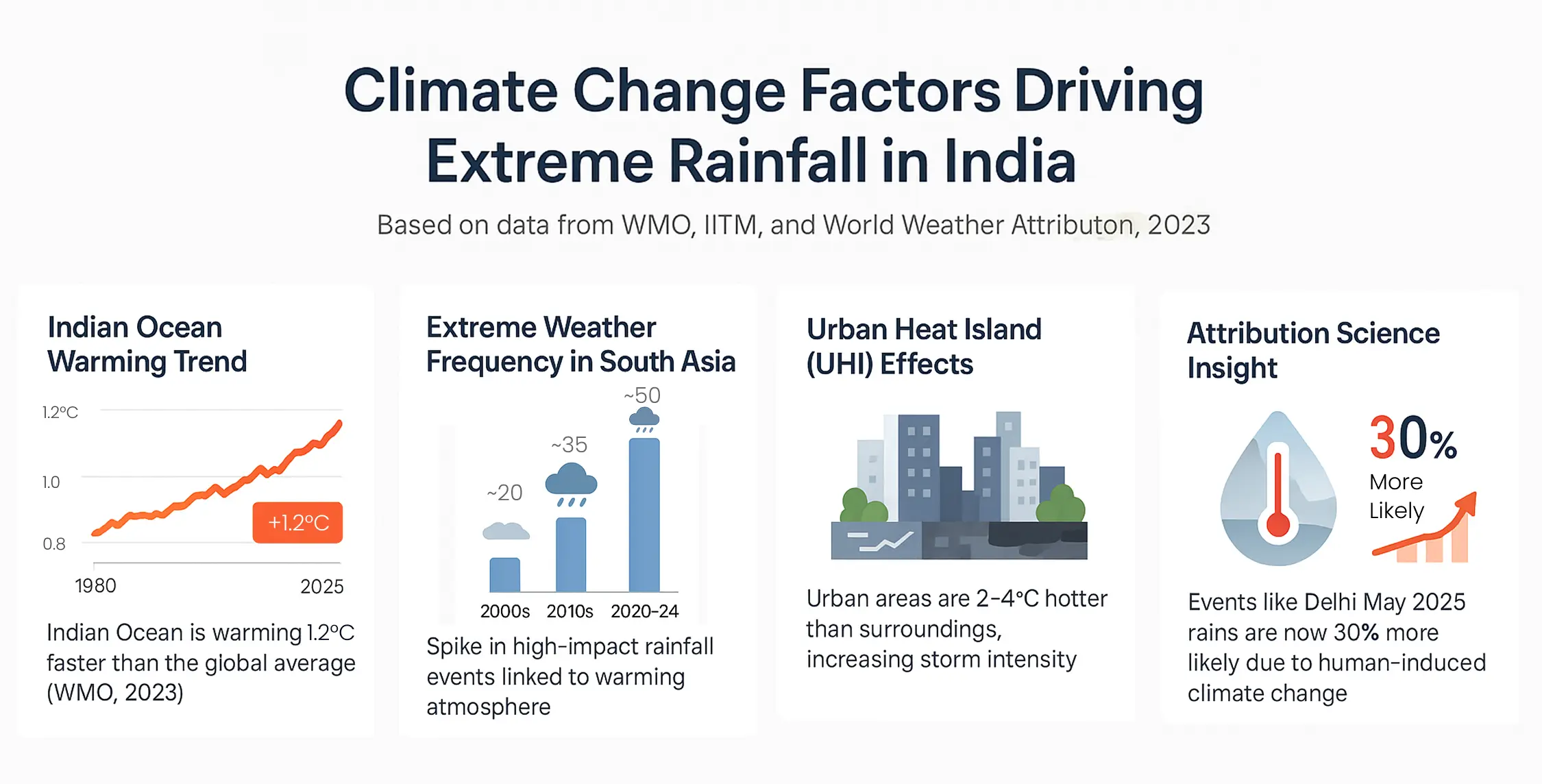In the midst of scorching heat, Delhi faced unprecedented rainfall in May 2025. This condition has made it the wettest May on record since 1901 and captured the record-breaking Delhi rain in May 2025. Delhi and the National Capital Region (NCR) have been experiencing an extraordinary spell of rainfall in May 2025, with record-breaking precipitation, thunderstorms, widespread waterlogging, uprooted trees, power outages, and travel disruptions. Meanwhile, as weather alerts continue into the last week of the month, residents are dealing with unusual conditions that experts say clearly show the effects of climate change.
Delhi Rain May 2025: What Really Happened in May 2025?
This May 2025, Delhi recorded its highest rainfall since 1901, registering 186.4 mm of rain by May 25. Hence, the previous breaking record was 165 mm in May 2008, exactly after 17 years. Delhi faced unprecedented rainfall in May 2025, making it the wettest May on record since 1901. Hence, residents are facing record-breaking Delhi rain in May 2025.

PTI Via IndiaTvNews
The city recorded a cumulative rainfall of 186.4 mm by May 25, 2025, surpassing previous records. A significant event on May 25 saw 81.4 mm of rain in just a few hours, classified as “heavy” and noted as the second-highest 24-hour May rainfall since 2021.
Moreover, experts suggest that frequent western disturbances and cyclonic circulations, possibly linked to climate change, contributed to these storms. The unusual weather pattern, with four major storms in May and a dust storm earlier, indicates potential recurring issues, though further research is ongoing.
| Impact Category | Details |
| Waterlogging | Widespread, affecting many parts of the city, reported by multiple sources |
| Flight Disruptions | Major issues at the airport, around 400 flights affected, per context |
| Wind Damage | Gusts up to 82 km/h, uprooted trees, damaged infrastructure |
| Casualties | At least 12 deaths due to collapsing structures, per Economic Times |
| Temperature Drop | Significant, with max 31.6°C and min 19.8°C on May 25. Source |
How This Year is Different? Why Record-Breaking Delhi Rain in May 2025?
Typically, May is among the hottest and driest months in Delhi. Because average rainfall usually hovers around 20-30 mm. In contrast, 2025 saw:
- Over 6x the average rainfall
- Early and frequent thunderstorms
- Cooler-than-normal daytime temperatures (due to persistent cloud cover)

The sheer scale and intensity of the storms have not only broken records but also defied traditional weather patterns, pushing experts to investigate deeper climatic causes.
Behind the Record-Breaking Delhi Rain in May 2025: Scientific Insights and New Research
Recent analysis from the Indian Institute of Tropical Meteorology (IITM) and the Centre for Climate Change Research (CCCR) points to a combination of natural and anthropogenic causes:
1. High-Frequency Western Disturbances (WDs)
Normally 2–3 WDs occur in May. However, in 2025, at least 6 systems have passed through North India. These WDs now carry more moisture due to elevated sea surface temperatures in the Mediterranean and Arabian seas.
2. Persistent Upper-Air Cyclonic Circulation
Studies using ERA5 reanalysis data show that a quasi-stationary cyclonic vortex has hovered over Rajasthan and Haryana for over 10 days—an anomaly not seen in the last two decades.
3. Weakening El Niño with Residual Atmospheric Instability
El Niño conditions earlier this year led to atmospheric destabilization that hasn’t fully dissipated, leading to more convective storms.
4. Aerosol-Climate Feedback Loops
New studies from IIT Delhi show particulate aerosols interacting with convective clouds over Delhi, enhancing rain intensity through microphysical cloud processes.
5. Urban Heat Islands (UHI)
Satellite data shows Delhi’s urban canopy has expanded rapidly post-2020, thus increasing localized convection and enhancing storm severity.
The Climate Change Connection
The correlation between extreme rainfall and global warming or is no longer speculative. Key points from global and regional studies include:

- Indian Ocean Warming: According to a 2023 World Meteorological Organization (WMO) report, the Indian Ocean is warming at 1.2x the global average, driving moisture-laden winds further inland.
- Jet Stream Disruption: As per a 2024 Nature Geoscience study, altered polar jet streams are leading to slower-moving weather systems, causing prolonged rainfall events.
- Climate Attribution Studies: Research by the World Weather Attribution initiative confirms that rainfall events like those in Delhi have become 30% more likely due to anthropogenic emissions.
Practical Measures for Mitigation
Addressing these challenges requires practical measures, as suggested by different sources. Since, this mitigation can help in reducing the risk of infrastructure and human loss:
Better Drainage System: The monsoon audits but the government can help in ensuring water drains, tanks, and different functional water bodies. Through this, the rain water can be stored for recycling wastewater and used it as fresh water.
Improvement of roads: Furthermore, waterlogging can be prevented by better planning of road construction without potholes and improved drainage at each end.
Protecting Green spaces: Urban forests, wetlands, rivers, and lakes work as a natural sponge of rain water. Because, it can help in protecting the ecosystem from flood-like situations. Early action and warning: Residents living near the drainage or river areas should be at high alert before the heavy rainfall to protect them from extreme conditions.
Conclusion
The May 2025 rainfall crisis in Delhi is more than just a meteorological record—it’s a climate wake-up call. As cities grow and weather changes, adjusting to this new reality is a must. Thus with the right mix of science, good policies, and public support, Delhi can turn this heavy rainfall into an opportunity for sustainable change.